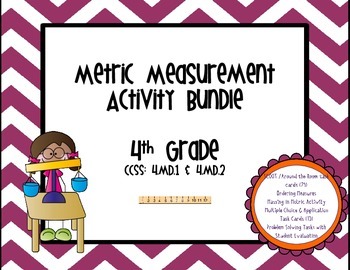Metric Measurement Activity Set
Elementary Brown-ies
542 Followers
Grade Levels
3rd - 5th, Homeschool
Subjects
Resource Type
Standards
CCSS4.MD.A.1
CCSS4.MD.A.2
CCSSMP1
CCSSMP2
CCSSMP3
Formats Included
- PDF
Pages
47 pages
Elementary Brown-ies
542 Followers
Description
This Metric Measurement Activity Set is geared to the 4th grade CCSS standards: 4.MD.1 and 4.MD.2. This set can also be used as differentiation for third grade measurement standards. These tasks include activities focusing on metric mass, capacity, and length.
Set Includes:
Metric Measurement Conversions Spinner Activity
Metric Measurement Conversions Spinner Activity recording sheet
Spin a Metric Word Problem Activity
24 SCOOT/Around the Room Cards
SCOOT/Around the Room Recording Sheet and Answer Key
Measuring Metric Mass Hands-on Activity (Fall themed)
Measuring Metric Mass Hands-on Activity (create your own)
6 large word problem posters for students to solve
Carousel Walk Student Evaluation Rubric
Ordering Metric Length Activity Cards (12 Cards)
Ordering Metric Length Answer Key
15 Metric Measurement Application/Multiple Choice Task Cards with Answer Key
Set Includes:
Metric Measurement Conversions Spinner Activity
Metric Measurement Conversions Spinner Activity recording sheet
Spin a Metric Word Problem Activity
24 SCOOT/Around the Room Cards
SCOOT/Around the Room Recording Sheet and Answer Key
Measuring Metric Mass Hands-on Activity (Fall themed)
Measuring Metric Mass Hands-on Activity (create your own)
6 large word problem posters for students to solve
Carousel Walk Student Evaluation Rubric
Ordering Metric Length Activity Cards (12 Cards)
Ordering Metric Length Answer Key
15 Metric Measurement Application/Multiple Choice Task Cards with Answer Key
Total Pages
47 pages
Answer Key
Included
Teaching Duration
1 Week
Report this resource to TPT
Reported resources will be reviewed by our team. Report this resource to let us know if this resource violates TPT’s content guidelines.
Standards
to see state-specific standards (only available in the US).
CCSS4.MD.A.1
Know relative sizes of measurement units within one system of units including km, m, cm; kg, g; lb, oz.; l, ml; hr, min, sec. Within a single system of measurement, express measurements in a larger unit in terms of a smaller unit. Record measurement equivalents in a two-column table. For example, know that 1 ft is 12 times as long as 1 in. Express the length of a 4 ft snake as 48 in. Generate a conversion table for feet and inches listing the number pairs (1, 12), (2, 24), (3, 36),...
CCSS4.MD.A.2
Use the four operations to solve word problems involving distances, intervals of time, liquid volumes, masses of objects, and money, including problems involving simple fractions or decimals, and problems that require expressing measurements given in a larger unit in terms of a smaller unit. Represent measurement quantities using diagrams such as number line diagrams that feature a measurement scale.
CCSSMP1
Make sense of problems and persevere in solving them. Mathematically proficient students start by explaining to themselves the meaning of a problem and looking for entry points to its solution. They analyze givens, constraints, relationships, and goals. They make conjectures about the form and meaning of the solution and plan a solution pathway rather than simply jumping into a solution attempt. They consider analogous problems, and try special cases and simpler forms of the original problem in order to gain insight into its solution. They monitor and evaluate their progress and change course if necessary. Older students might, depending on the context of the problem, transform algebraic expressions or change the viewing window on their graphing calculator to get the information they need. Mathematically proficient students can explain correspondences between equations, verbal descriptions, tables, and graphs or draw diagrams of important features and relationships, graph data, and search for regularity or trends. Younger students might rely on using concrete objects or pictures to help conceptualize and solve a problem. Mathematically proficient students check their answers to problems using a different method, and they continually ask themselves, "Does this make sense?" They can understand the approaches of others to solving complex problems and identify correspondences between different approaches.
CCSSMP2
Reason abstractly and quantitatively. Mathematically proficient students make sense of quantities and their relationships in problem situations. They bring two complementary abilities to bear on problems involving quantitative relationships: the ability to decontextualize-to abstract a given situation and represent it symbolically and manipulate the representing symbols as if they have a life of their own, without necessarily attending to their referents-and the ability to contextualize, to pause as needed during the manipulation process in order to probe into the referents for the symbols involved. Quantitative reasoning entails habits of creating a coherent representation of the problem at hand; considering the units involved; attending to the meaning of quantities, not just how to compute them; and knowing and flexibly using different properties of operations and objects.
CCSSMP3
Construct viable arguments and critique the reasoning of others. Mathematically proficient students understand and use stated assumptions, definitions, and previously established results in constructing arguments. They make conjectures and build a logical progression of statements to explore the truth of their conjectures. They are able to analyze situations by breaking them into cases, and can recognize and use counterexamples. They justify their conclusions, communicate them to others, and respond to the arguments of others. They reason inductively about data, making plausible arguments that take into account the context from which the data arose. Mathematically proficient students are also able to compare the effectiveness of two plausible arguments, distinguish correct logic or reasoning from that which is flawed, and-if there is a flaw in an argument-explain what it is. Elementary students can construct arguments using concrete referents such as objects, drawings, diagrams, and actions. Such arguments can make sense and be correct, even though they are not generalized or made formal until later grades. Later, students learn to determine domains to which an argument applies. Students at all grades can listen or read the arguments of others, decide whether they make sense, and ask useful questions to clarify or improve the arguments.





